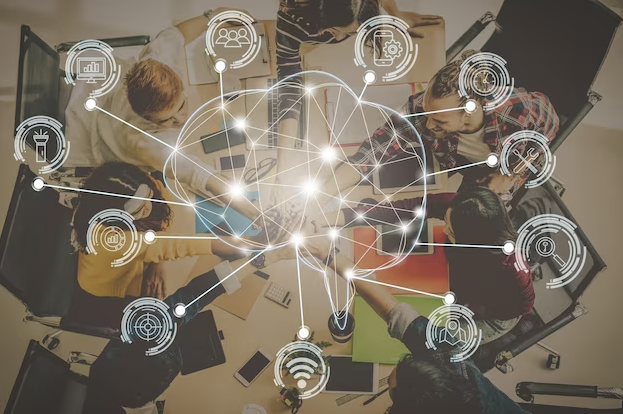In our digitally-driven world, the significance of robust and efficient communication technologies cannot be overstated. As we navigate the dynamic landscape of the 21st century, broadband networks and next-generation communication technologies stand at the forefront of technological innovation, reshaping how we connect, communicate, and conduct business. This comprehensive article delves into the intricacies of broadband networks, exploring the evolution, current state, and prospects of these transformative technologies.
The Evolution of Broadband Networks
Historical Perspective
To understand the current landscape of broadband networks, it is essential to trace their evolution from humble beginnings. The journey began with dial-up connections and has rapidly progressed through various phases, including the advent of DSL, cable, and fiber-optic technologies. The historical context provides valuable insights into the challenges and breakthroughs that have paved the way for the sophisticated broadband networks like earthlink internet plans we rely on today.
Milestones in Broadband Development
Dial-Up to Broadband: A Quantum Leap
The transition from dial-up connections to broadband marked a significant milestone in the history of communication technologies. The advent of broadband brought about unparalleled speed and reliability, enabling users to access the internet seamlessly.
DSL and Cable: Expanding Connectivity
The introduction of Digital Subscriber Line (DSL) and cable technologies further expanded the reach of broadband networks. These innovations addressed some of the limitations of early broadband, offering improved speed and stability to a broader audience.
Fiber-Optic Revolution
Fiber-optic technology emerged as a game-changer, revolutionizing the speed and efficiency of data transmission. With the capability to transmit large amounts of data at the speed of light, fiber-optic networks became the backbone of high-speed internet services.
Next-Generation Communication Technologies
5G Technology: Unleashing the Power of Connectivity
The fifth generation of wireless technology like earthlink internet plans, commonly known as 5G, has garnered significant attention for its transformative impact on communication. With exponentially faster speeds, lower latency, and increased capacity, 5G is poised to revolutionize how devices and people communicate in the digital age.
Internet of Things (IoT): A Network of Everything
The proliferation of IoT devices is reshaping how we interact with our surroundings. IoT relies on robust communication networks from smart homes to industrial applications to facilitate seamless connectivity and data exchange. The integration of IoT into our daily lives is a testament to the potential of next-generation technologies.
Artificial Intelligence and Machine Learning in Communication
Artificial Intelligence (AI) and Machine Learning (ML) are pivotal in enhancing communication technologies. From predictive analytics to natural language processing, these technologies optimize network performance, improve user experiences, and enable proactive problem-solving.
EarthLink Internet Plans: Navigating the Digital Frontier
Understanding EarthLink’s Commitment to Connectivity
EarthLink has established itself as a key player in the competitive landscape of internet service providers, offering a range of internet plans designed to cater to diverse user needs. With a focus on reliability, speed, and customer satisfaction, EarthLink’s internet plans aim to provide seamless connectivity in an ever-evolving digital ecosystem.
Exploring EarthLink’s Broadband Offerings
EarthLink’s Fiber-Optic Plans
EarthLink’s commitment to cutting-edge technology is evident in its fiber-optic internet plans. With lightning-fast speeds and unparalleled reliability, these plans are designed to meet the demands of modern users who rely on high-performance connectivity for work, entertainment, and more.
DSL and Cable Options
EarthLink offers DSL and cable internet plans for users in areas where fiber-optic connectivity may not be available. These options provide reliable and high-speed internet access, ensuring that a broader audience can benefit from EarthLink’s commitment to connectivity.
The Future Landscape: Challenges and Opportunities
Security Concerns in Next-Generation Networks
As communication technologies advance, the need for robust cybersecurity measures becomes paramount. The interconnected nature of devices and networks in the digital age exposes vulnerabilities that require proactive solutions to safeguard sensitive information and ensure user privacy.
Regulatory Landscape and Policy Implications
The rapid evolution of communication technologies challenges regulatory frameworks and policies. Governments and regulatory bodies must adapt to ensure fair competition, consumer protection, and the responsible deployment of emerging technologies.
Sustainable Practices in Communication Technologies
The exponential growth in data consumption and the expansion of communication networks raise concerns about environmental sustainability. The industry must explore eco-friendly practices and technologies to mitigate the ecological impact of broadband networks and ensure a sustainable digital future.
Case Studies: Global Initiatives and Success Stories
South Korea’s 5G Leadership
South Korea has emerged as a global leader in 5G adoption, showcasing the transformative power of next-generation communication technologies. Examining South Korea’s journey provides valuable insights into the economic, social, and technological benefits that advanced communication infrastructure can bring to a nation.
Singapore’s Smart Nation Initiative
Singapore’s Smart Nation initiative exemplifies a holistic approach to integrating communication technologies into the fabric of society. From smart infrastructure to digital governance, Singapore’s success story is a blueprint for leveraging next-generation technologies for comprehensive societal development.
Frequently Asked Questions (FAQs)
What is the historical evolution of broadband networks, and how have they transformed over the years?
Broadband networks have evolved remarkably, transitioning from dial-up connections to DSL, cable, and, eventually, fiber-optic technologies. The historical perspective provides insights into the challenges and breakthroughs that shaped today’s sophisticated broadband networks.
How has EarthLink positioned itself in the internet service provider market, and what distinguishes its internet plans?
EarthLink has established itself as a key player in the competitive ISP market, offering a range of internet plans designed for diverse user needs. With a focus on reliability, speed, and customer satisfaction, EarthLink’s internet plans aim to provide seamless connectivity in the rapidly evolving digital landscape.
What role does 5G technology play in the next-generation communication landscape, and how does it differ from previous wireless technologies?
The fifth generation of wireless technology, 5G, brings exponential improvements in speed, lower latency, and increased capacity. It is set to revolutionize communication by enabling faster and more reliable connections for devices and people, distinguishing itself from its predecessors.
How does EarthLink address the connectivity needs of users through its fiber-optic, DSL, and cable internet plans?
EarthLink offers various internet plans, including fiber-optic, DSL, and cable options. These plans cater to different user requirements, providing reliable and high-speed internet access and ensuring a broad audience can benefit from EarthLink’s commitment to connectivity.
What role do Artificial Intelligence (AI) and Machine Learning (ML) play in optimizing communication technologies, and how are they integrated into modern networks?
AI and ML significantly enhance communication technologies by optimizing network performance, improving user experiences, and enabling proactive problem-solving. These technologies are integrated into modern networks to ensure efficiency and responsiveness.
What are the key security concerns of next-generation communication technologies, and how can they be addressed?
As communication technologies advance, security concerns become paramount. The interconnected nature of devices and networks in the digital age exposes vulnerabilities that require robust cybersecurity measures to safeguard sensitive information and ensure user privacy.
How do the regulatory landscape and policy implications affect the deployment of next-generation communication technologies?
The rapid evolution of communication technologies poses challenges to regulatory frameworks and policies. Governments and regulatory bodies must adapt to ensure fair competition, consumer protection, and responsible deployment of emerging technologies.
How can the communication industry address environmental sustainability concerns related to data consumption and network expansion?
The exponential growth in data consumption and the expansion of communication networks raise concerns about environmental sustainability. The industry must explore eco-friendly practices and technologies to mitigate the environmental impact and ensure a sustainable digital future.
Can you provide examples of global initiatives and success stories related to next-generation communication technologies?
Examining global initiatives such as South Korea’s 5G leadership and Singapore’s Smart Nation initiative offers valuable insights into the economic, social, and technological benefits that advanced communication infrastructure can bring to a nation, inspiring other regions.
Conclusion: Navigating the Digital Frontier
In conclusion, broadband networks and next-generation communication technologies are at the forefront of shaping our interconnected future. The evolution from dial-up to fiber-optic, coupled with the advent of 5G, IoT, and AI, has ushered in an era of unparalleled connectivity. EarthLink’s internet plans, focusing on reliability and performance, contribute to this digital transformation. As we navigate the challenges and opportunities in the evolving landscape, it is crucial to prioritize security, regulatory frameworks, and sustainable practices to ensure a seamless and responsible digital future.



